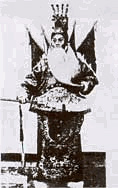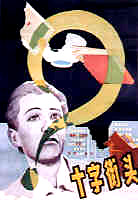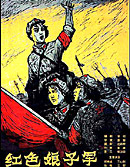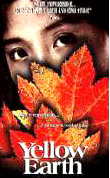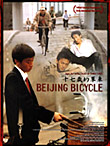Motion pictures were introduced to China in 1896. The first attempt at filmmaking was
Conquering Jun Mountain (1905). The Chinese film industry didn't begin until 1913 when Zheng Zhengqiu and Zhang Shichuan shot the first Chinese movie
The Difficult Couple (1913). During the 1920s film technicians from the United States trained Chinese technicians in Shanghai, an early filmmaking center, and American influence continued to be felt there for the next two decades. China's first "talkie" was
The Songstress, Red Peony (1931) played by the then "film queen" Butterfly Hu (Hu Die in Chinese) and produced by the Star Studio, Shanghai's largest film production studio.
Before the 1930s, owing to a lack of creativity, films made in China didn't exert a big influence in its history. Since then, the story of the film industry in China is like a summary of the nation's modern history, dealing with people's tortured and revolutionary life before 1949, the war of resistance against Japanese aggression, the civil war, the establishment and frustrating era of the P.R.China, its economic development and challenges to the status quo after WTO entry.
During 1933 and 1935, the left-wing movement (resistance against imperialism and
feudalism) in filmmaking was introduced to Shanghai and flourished.
Torrents (1933) (Kuangliu in Chinese), directed by Xia Yan and Cheng Bugao and produced by the Star Studio, was the first film of this genre. Many famed directors came to the fore and made outstanding contributions in art and literature, such as Yuan Muzhi's
Street Angel (1937) and Shen Xiling's
Crossroad (1937). They brought the darker, seamier side of society to light and gave expression to the wishes of the people to pursue their dreams as well as rebel against imperialism and feudalism. A great variety of artistic images were born and a number of acclaimed actors and actresses emerged. Butterfly Hu, Zhao Dan, Zhou Xuan and Shu Xiuwen were amongst them.
In the 1940s, on the eve of China's liberation, filmmaking was in a chaotic state and some
profiteers seized the chance to shoot blue films and scary movies. However there were still some wonderful films being made thanks to the concerted efforts of conscientious filmmakers, who made classics such as
Spring River Flows Eastward (1947) by Cai Chusheng and Zheng Junli,
Crow and Sparrow (1949) by Chen Baichen and Zheng Junli and
Light of Million Hopes (1948) by Shen Fu. These films had high artistic value in screenplay writing, directing, performance, cinematography, music, art design and other aspects. Filmmaking developed more quickly in the 1940s than it had in the 1930s.
China's film industry experienced hardships and setbacks after the founding of the People's Republic of China in 1949. The beginning was brilliant with many fine movies showing on the screen. Most of these tell stories about the war of resistance against the
Japanese aggression as well as about the civil war, such as
Dong Cunrui (1955) by Guo Wei and
The Red Detachment of Women (1961) by Xie Jin. These movies made everything seem fresh due to lively roles and plot. But at the same time they had a severe shortage and were limited by a lack of individual artistic character as well as different photographic style. Artistic rules were usually neglected. In this aspect, films made in the 1950s were inferior to those made earlier. In the 17 years between the establishment of P.R. China and the "Cultural Revolution" (1966-1976), 603 feature films and 8,342 reels of documentary and news were made. The first wide-screen film was produced in 1960.
Filmmaking fell on "disaster time" during the Cultural Revolution. The film industry was severely restricted and no film was shot in the period 1966 and 1972. Films made between 1973-76 were strongly affected by revolutionary thinking and became tools of the Gang of Four. The films made then more or less reflected the real situation of China during the "Cultural Revolution".
In the years immediately following the "Cultural Revolution", artists in film began to free their minds and the film industry again flourished as a medium of popular entertainment. Animated films using a variety of folk arts, such as paper cuts, shadow plays, puppetry, and traditional painting, were also very popular with children.
In the 1980s, China's filmmakers started an all-round exploration and the range of film subjects extended. Films depicting the good and evil of the "Cultural Revolution" were very popular with the ordinary person. Many realism films reflecting the transformation of society as well as people's ideology were produced.
Early in 1984, a film One and Eight (1984) made mainly by the graduates of the Beijing
Film Academy shocked China's film industry. The film, together with Chen Kaige's
Yellow Earth (1984) made people experience the magic of the fifth generation of filmmakers, including Wu Ziniu, Tian Zhuangzhuang, Huang Jianxin and He Ping. Amongst this group Zhang Yimou first won an international prize with
Red Sorghum (1987). Unlike the middle-aged fourth generation directors, they broke with traditional filmmaking, in screenplay and film structure as well as narrative. In January 1986 the film industry was transferred from the Ministry of Culture to the newly formed Ministry of Radio, Film and Television to bring it under "stricter control and management" and to "strengthen supervision over production."
In the 1990s, China experienced prosperity in its film industry. At the same time the government allowed the showing of foreign movies from 1995. More of China's films won awards at international film festivals, such as Ju Dou (1990) and To Live (1994) by Zhang Yimou, Farewell My Concubine (1993) by Chen Kaige, Blush (1994) by Li Shaohong, and Red Firecracker Green Firecracker (1993) by He Ping. However, these films encountered more and more criticism, in particular for their stylized form and neglect of audience response and absence of representation of the spiritual bewilderment of the people during the transformation of Chinese society.
In the mean time, a group of spirited young filmmakers began throwing away the fashionable cinematic veneer and facing reality. They were the sixth generation: Zhang Yuan,
East Palace West Palace (1996), Wang Xiaoshuai,
Beijing Bicycle (2000), Jia Zhangke,
Unknown Pleasure (2002), Jiang Wen,
Devils on the Doorstep (1999), Lu Xuechang,
The Making of Steel (1996) and many others. Their serious attitude toward the art of film and life was to create youthful vigor in China's film industry for the start of the new millennium.
(China.org.cn by Lixiao January 17, 2004)


